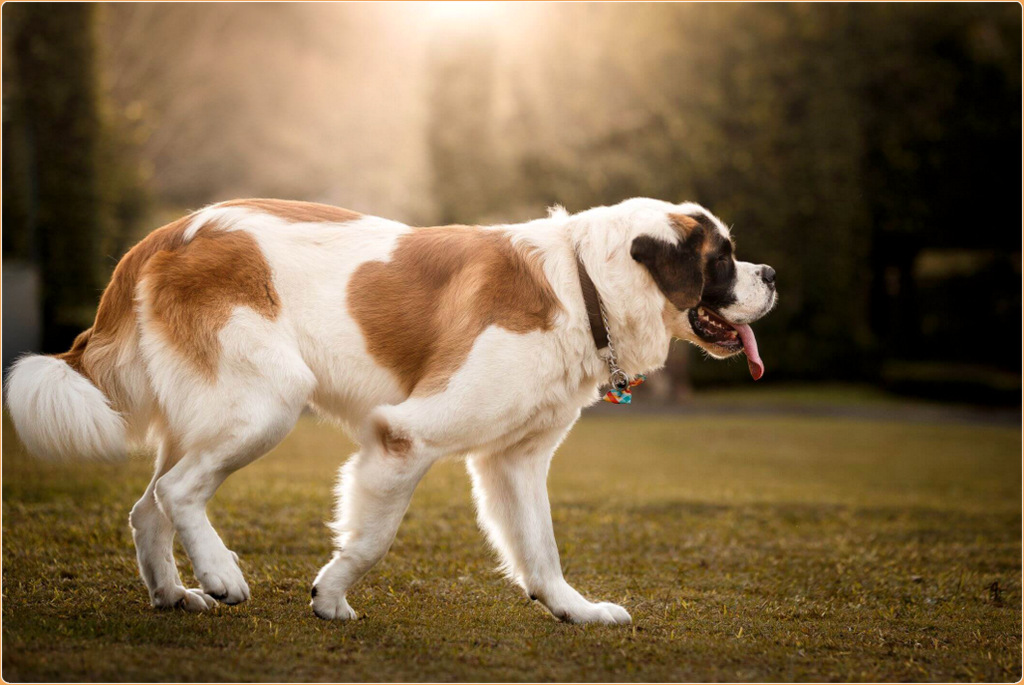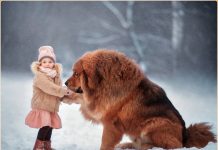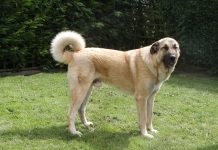St. Bernard is famous for its huge size and versatility. They were used to rescue travelers at the St. Bernard pass. They act as savior of travellers by rescuing the lost ones and injured ones. The dog is also an efficient guard dog. It also excels in weight pulling sports.
Despite being a giant, the dog is sweet tempered and gentle with family members. He does well in apartment, provided you give it opportunity to vent out its energy. It remains calm and composed inside home after his exercise regime.
If you are a fastidious housekeeper, the dog is not meant for you. It drools and sheds heavily which could make your house messy. They are not excessive vocal but will bark if they suspect anything wrong in the environment. Its size is deterrent to attack trespassers or burglars.
They are patient and playful around children but young children should be taken care because they can knock them down with a swing of their tail. The dog is also not meant for hot temperature areas. Even in moderate warm climate, they need access to shade and cold water. On the other hand, the dog enjoys snow and loves to romp in it.
Origin
St. Bernard used to be lifesaving dog of stranded travellers in the Swiss Alps. The dog licks the face of frozen traveller to provide warmth, would track lost person and lay next to person to tolerate chilly wind. Clear information about its origin is vague but experts believe that the dog belongs to Switzerland and is developed by cross mating native Alps dogs with Mastiff-type dogs. Experts also say that the dog was first used by the hospice monks because of its ability to revive ill and lost travellers. It was also used as sledge dog.

St. Bernard Facts And Characteristics
- The dog belongs to Switzerland and is a working class breed
- The dog remains calm and suited for apartment only if it has big rooms where dog can stretch and live comfortably
- The dog can easily survive the chilly weather but it is not suitable for hot temperature
- The dog takes time to mature. They remain in puppyhood stage even after reaching 2 years of age
- The dog never barks without cause so beware if it barks. It must be for some reason
- It is a short lived The lifespan of the dog is 8 to 10 years
- The dog thrives better inside home with family
- Weight of the dog ranges from 64 – 120 kg
- The height of the dog lies between 70–90 cm
- The dog is not suitable for family with small babies because they can accidentally knock them down
- It is a lively, watchful, alert and affectionate family dog
- The dog is not a hypoallergenic breed
- Price of the puppy is $1000 to $15000.
Saint Bernard Appearance
St. Bernard also called as Alpine mastiff is a massive sized dog with a muscular body. Their faces are well developed with cheek bones and deep muzzle. Its flat ears are of medium size and set atop the head. The nose is big and dark in color with well-developed nostrils. It has deep set, dark brown color eyes. The back is muscular, straight and strong. Tail is bushy, thick and is carried upward.
-
Size and Weight
Male should range from 70–90 cm while female height should range from 65–80 cm. Ideal weight of both the genders should be between 64 – 120 kg.
-
Coat and Color
It can possess either short coat or long coat. Short coat is dense and even. Bushy hair is found in legs, tails and underbelly. Long coat should be wavy but not curly or straight. Feather like hair is found in thighs, tail and neck region. Coat color ranges in various shade of white and red.
Saint Bernard Temperament
- Personality – The dog has a naturally tendency to help people and provide them solace. It understands human emotions well and will do anything to bring smile on humans face. Because of its helpful naturethe dog is still used as mountain rescues. The dog remains clumsy even if it has grown up. It loves to wander and can unintentionally knocks any of the decorative items kept in your home. Make sure to secure such item before planning to buy this breed. The dog is fond of snow weather. It can play till hours in the snow. The dog also doesn’t mind to nap in the afternoon. It loves to play with children and is docile with them.
- Behavior – If you’re a neat freak, this breed is not for you. They have a tendency to eat and drink water in a messy way. They also droola lot. The dog is not aggressive in nature but if you keep your dog devoid of food and outside activity it can turn destructive.
- Activities Requirement – Winter is his favorite time and you don’t have to motivate your to dog to exercise. But in summers, they prefer to remain inside home. The exercise needs of the dog are moderate. Twice a walk around the park is sufficient for it.
- Trainability – Patience and firmness is required to train your dog. Start the training as soon as you bring it home. Training can be difficult because they tend to be stubborn and willful minded. The dog responds well to treat. Being harsh on your dog can backfire you so be gentle on it.
Saint Bernard Feeding
Recommended daily amount of food is 5 to 6 cups of high quality dry food divided into two to three equal meals. They are prone to bloat, so rather than giving one large meal, provide them with 2-3 small meals a day. Saint Bernard is prone to obesity, measure the weight and calorie consumption at regular intervals.
Puppies eat 2 cups of food a day and as they grow they eat 4 cups. Provide them half dry food and half canned food to prevent stomach swell up. Provide water all the time near the dog but give few slurps of water after eating to prevent bloat.
Lifespan
The dog lives up to 8 to 10 years of age.
Saint Bernard Health Issues
The dog is not hypoallergenic in nature. Breed health concern may include
- Dilated cardiomyopathy
- Lip fold pyoderma
- Cherry eye
- Bloat and osteosarcoma
- Osteochondritis dissecans
- Deafness
- Epilepsy
Saint Bernard Grooming and Caring
Brush them two to three times a week with a Pin brush to comb long haired coat and hound glove or rubber curry brush to brush short haired coats. Use shedding blade to remove loose hair during shedding seasons. They don’t require frequent bathing.
Clean tear stains with wet approved solution. Check ears periodically and clean them if dirty using cotton ball dampened in wet approved ear cleanser. Trim ails once or twice a month and during trimming nails, trim the hair between the toes. Brush their teeth two to three times a week to reduce tartar buildup, and for better prevention of bad breath and gum disease, daily brushing is recommended.
Habitat
The dog thrives in apartment that has big room so that the dog doesn’t have to confine itself to small space. The dog thrives well in the cold climate regions and is fond of a snowfall.

Saint Bernard Pet Names
- Khali
- King
- Dracula
- Dragon
- Sumo
Things To Consider Before Buying
Pros
- A dog rescuer, this breed helps the travelers of Alpine passage
- It makes wonderful watch dog and guard dog
- The dog craves for human companionship and makes good family dog
- The dog has moderate exercise needs. Suitable for not so active owners.
Cons
- Comparatively the lifespan of the dog is less (8 to 10 years)
- It is not a hypoallergenic breed and is prone health issues
- The dog is not suitable for family having small children
- The dog drools a lot and is not suitable for cleanliness obsessed people.



